Adil Najam
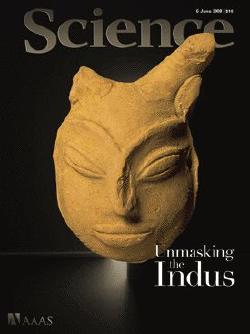 A recent cover story in the prestigious journal Science reports that the scientific view of the Indus Civilization, of how it compares to its other two contemporary civilizations (Mesopotamia and Egypt), and of what might have happened to it is undergoing a stark and important reconsideration. That scientists consider it to be “Boring No More” and, indeed, the emerging new understanding of the Indus Civilization suggests that it might have been “a powerhouse of commerce and technology in the 3rd millennium B.C.E.”
A recent cover story in the prestigious journal Science reports that the scientific view of the Indus Civilization, of how it compares to its other two contemporary civilizations (Mesopotamia and Egypt), and of what might have happened to it is undergoing a stark and important reconsideration. That scientists consider it to be “Boring No More” and, indeed, the emerging new understanding of the Indus Civilization suggests that it might have been “a powerhouse of commerce and technology in the 3rd millennium B.C.E.”
I must confess that I am late in reporting about, and nearly missed, the June 6 cover story by Andrew Lawler, titled “Unmasking the Indus” (Science, Vol. 320, p. 1276-1285). I have been traveling out of the country, nearly non-stop, for the last seven weeks and only just got to the stack of Nature and Science (two of my favorite magazines) that had piled up in the unread mail. Of course, one look at the cover – which depicts a “bearded, horned terra cotta mask, about 5 centimeters in height, found at Mohenjo Daro, Pakistan” – had me hooked on what is unusually detailed (10-page long, with 6 sub-reports) and gripping report on the exciting new knowledge and understanding of the Indus Civilization that is beginning to emerge; knowledge that is beginning to question our long-held assumptions about what the civilization was, or was not.
Of course, there is much written about the Indus Civilization, including fascinating and detailed reports in National Geographic, etc., but this Science report is different because it highlights how our scientific – in this case archaeological – knowledge on the subject is not only expanding, but changing. It really is worth reading in the full and I would encourage readers to do so.
The opening few paragraphs of the lead essay – “Boring No More, a Trade-Savvy Indus Emerges” – give a flavor of the key argument:
THAR DESERT, PAKISTAN–Egypt has pyramids, temples, and mummies galore. Ancient Mesopotamians left behind the dramatic saga of Gilgamesh, receipts detailing their most prosaic economic transactions, and the occasional spectacular tomb. But the third of the world’s three first civilizations had, well, good plumbing. Even the archaeologists who first discovered the Indus civilization in the 1920s found the orderly streetscapes of houses built with uniform brick to be numbingly regimented. As recently as 2002, one scholar felt compelled to insist in a book that the remains left behind by the Indus people “are not boring.”
Striking new evidence from a host of excavations on both sides of the tense border that separates India and Pakistan has now definitively overturned that second-class status. No longer is the Indus the plain cousin of Egypt and Mesopotamia during the 3rd millennium B.C.E. Archaeologists now realize that the Indus dwarfed its grand neighbors in land area and population, surpassed them in many areas of engineering and technology, and was an aggressive player during humanity’s first flirtation with globalization 5000 years ago. The old notion that the Indus people were an insular, homogeneous, and egalitarian bunch is being replaced by a view of a diverse and dynamic society that stretched from the Arabian Sea to the foothills of the Himalaya and was eager to do business with peoples from Afghanistan to Iraq. And the Indus people worried enough about the privileges of their elite to build thick walls to protect them. “This idea that the Indus was dull and monolithic–that’s all nonsense,” says Louis Flam, an archaeologist at the City University of New York who has worked in Pakistan. “There was a tremendous amount of variety.”
… Even well-combed sites are still full of surprises: The city of Harappa may be 1000 years older and Mohenjo Daro far larger than once thought. And the dramatic “Buddhist stupa” adorning Mohenjo Daro’s high mound may in fact date back to the Indus heyday around 2000 B.C.E.
However, the problems remain serious. As the author points out:
…piecing together a cohesive new picture is hampered by the political discord between India and Pakistan. Many foreign archaeologists steer clear of Pakistan because of political instability, while India’s government–scarred by colonialism–often discourages researchers from collaborating with European or American teams. A virtual Cold War between the two countries leaves scientists and sites on one side nearly inaccessible to the other.
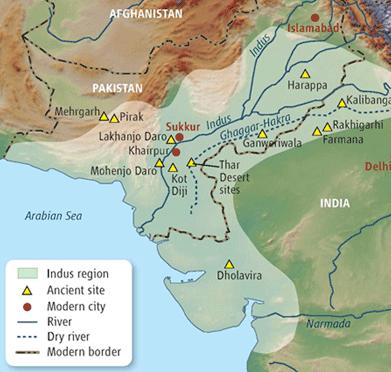 One key in this new wave is the knowledge that was unleashed with the discovery, in the 1970s by a French-led team, of Mehrgarh “dating to 7000 B.C.E. in the Baluchistan hills on the western fringe of the Indus valley.” The Science article points out:
One key in this new wave is the knowledge that was unleashed with the discovery, in the 1970s by a French-led team, of Mehrgarh “dating to 7000 B.C.E. in the Baluchistan hills on the western fringe of the Indus valley.” The Science article points out:
[Mehrgarh] is now widely accepted as a precursor to the Indus and clear proof of the indigenous nature of the later civilization. That idea gets new support from surveys here in the Thar Desert, on the eastern edge of the Indus valley. This area was long assumed to have been largely uninhabited before the rise of the Indus cities. But hundreds of small sites now show that humans lived here on the plains, not just in the Baluchistan hills, for several millennia prior to the rise of the Indus, says archaeologist Qasid Mallah of Shah Abdul Latif University in Khairpur.
Of course many mysteries remain – the largest probably about language and civilizational collapse – however, there is a key, and exciting difference:
For the first half-century after its discovery, the Indus was virtually synonymous with Mohenjo Daro and Harappa. No other major cities were known. But along with 1000 smaller sites, archaeologists now count at least five major urban areas and a handful of others of substantial size. These sites reveal new facets of Indus life, including signs of hierarchy and regional differences that suggest a society that was anything but dull and regimented.
One of the most fascinating aspect is about international trade:
While evidence accumulates from Indus cities, other insights are coming from beyond the region, as artifacts from Central Asia, Iraq, and Afghanistan show the long arm of Indus trade networks. Small and transportable Indus goods such as beads and pottery found their way across the Iranian plateau or by sea to Oman and Mesopotamia, and Indus seals show up in Central Asia as well as southern Iraq. An Indus trading center at Shortugai in northern Afghanistan funneled lapis to the homeland. And there is strong evidence for trade and cultural links between the Indus and cities in today’s Iran as well as Mesopotamia.
…”These people were aggressive traders, there is no doubt about it,” adds [Gregory] Possehl [ of the University of Pennsylvania], who has found Indus-style pottery made from Gujarat clay at a dig in Oman. Archaeologist Nilofer Shaikh, vice chancellor of Latif University, takes that assertion a step further, arguing that “the Indus people were controlling the trade. They controlled the quarries, the trade routes, and they knew where the markets were.”
She points out that although Indus artifacts spread far and wide, only a small number of Mesopotamian artifacts have been found at Indus sites. Evidence suggests that some Indus merchants and diplomats lived abroad, although the trade was certainly two-way. An inscription from the late 3rd millennium B.C.E. refers to one Shu-ilishu, an interpreter from Meluhha [a reference to the Indus civilization], reports NYU’s Wright in a forthcoming book. What may be Shu-ilishu and his wife are featured on a seal wearing Mesopotamian dress. There is some evidence for a village of Indus merchants between 2114 and 2004 B.C.E. in southern Iraq. And “a man from Meluhha” knocked out someone’s tooth during an altercation and was made to pay a fine, according to a cuneiform text, hinting at a life that was neither faceless nor boring.
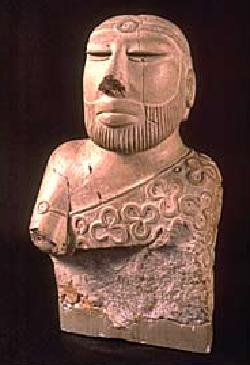 There is much more in the full report to keep the reader engrossed. How archeaologists are chronically short of resources. How archaeologist Farzand Masih from Punjab University, Lahore, who is excavating at Ganweriwala, Pakistan, and Vasant Shinde from Deccan College, Pune, who is excavating at Farmana, India, work a mere 200 kilometers apart but cannot collaborate on their findings. How part of the last remains of a 5000-year-old city known as Lakhanjo Daro has been lost to “development” and a factory is being built over the site. How the politics of religion threatens to undermine scientific integrity and matters of archeology are being played out in the Indian parliament as well as the courts. How looters and thieves are running away with treasures of the Indus civilization. And much more.
There is much more in the full report to keep the reader engrossed. How archeaologists are chronically short of resources. How archaeologist Farzand Masih from Punjab University, Lahore, who is excavating at Ganweriwala, Pakistan, and Vasant Shinde from Deccan College, Pune, who is excavating at Farmana, India, work a mere 200 kilometers apart but cannot collaborate on their findings. How part of the last remains of a 5000-year-old city known as Lakhanjo Daro has been lost to “development” and a factory is being built over the site. How the politics of religion threatens to undermine scientific integrity and matters of archeology are being played out in the Indian parliament as well as the courts. How looters and thieves are running away with treasures of the Indus civilization. And much more.
I do hope our readers will find the Science report as fascinating as I did.
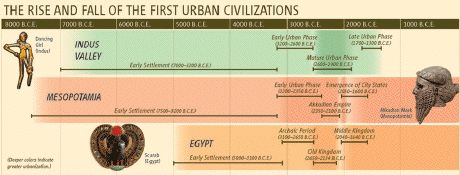
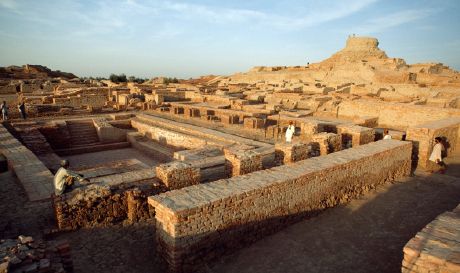



















































It is sad that archaeologists like Masih and Shinde, working towards the common goal of unravelling an ancient civilization, cannot collaborate on their findings. Haven’t our great politicians considered archaeology in Indo-Pak or SAARC talks yet?
Wonderful story. Can someone get the original articles in PDF format as I don’t have access to the magazine website?
adil why dont you write a piece for us on this?
Asalam Walaikum,
I liked reading this article. As more research is done it seems there are many new things to learn about civilisations based in Egypt/Nubian, Mesopotamia, Persia, and the Indian Subcontinent. It is worth learning about Chinese Civilisation (oldest human civilisation), and how these entities interacted with each other, via trade and exchange of ideas. Central Asia played a more important role in exchanges between China, Persia, and Indus Valley civilisations.
Nishat: You are thinking about the ‘sufism’ of Subcontinental variety. Yes that brand of ‘sufism’ is laced with Hindu and Buddhist thoughts and practices where Shrine substitutes the Temple and Pir stands in for the Guru. Singing and dancing at shrines is akin to Hindu worshiping in temples. Move away from the Indian Subcontinent to other Muslim lands and you will find different kinds of ‘sufism’ there, devoid to Hindu/Buddhist influence. Case in point are the different varieties of ‘cultural islam’ and ‘sufism’ practiced in Black Africa, Byzantine Eastern Europe, Ancient Anatolia or Asia Minor, Russia and Central Asia. The further one travels away from the Arabian Peninsula, diluted the Arab ‘cultural islam’ gets. Indian Subcontinent has no monopoly over ‘sufism’.